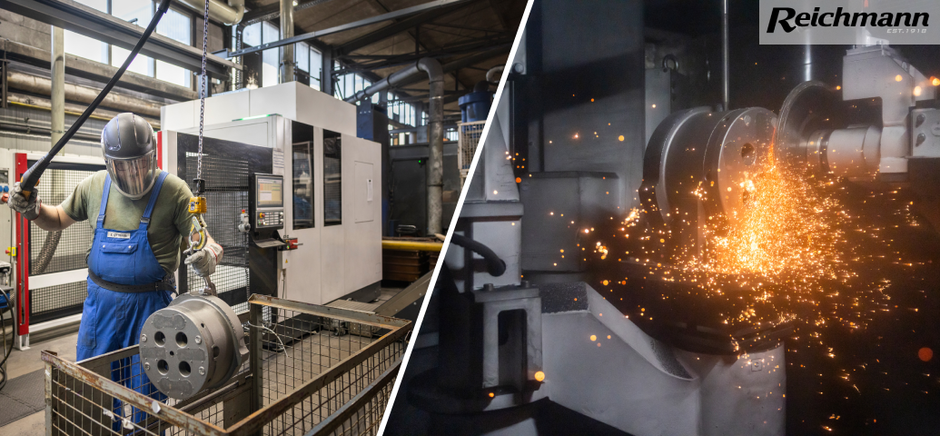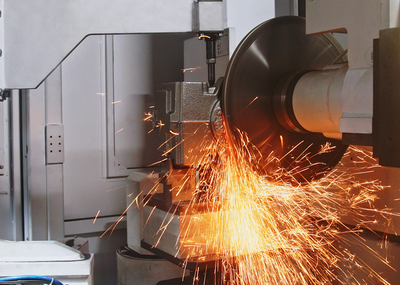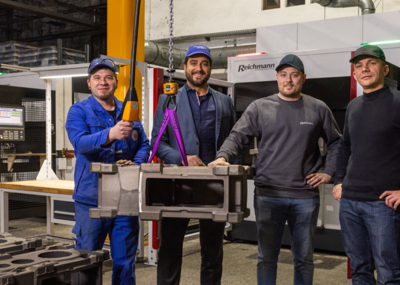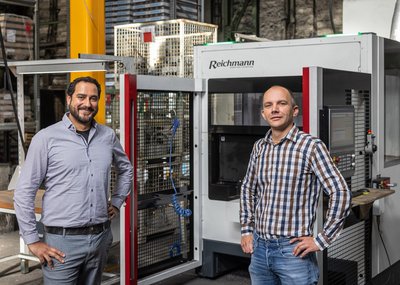New thinking instead of just new technology
Harz Guss Zorge, a medium-sized company with around 450 employees, has specialized in complex, core-intensive castings for decades – for Caterpillar, Liebherr, and MAN, among others. But despite this strong market position, those responsible faced key challenges: physically demanding work steps, a shortage of skilled workers, and increasing quality requirements.
"It was clear to us that we had to do something," explains Mario Zimmer, head of the finishing department. "We had to completely rethink our processes – from core production to finishing."
The goal was clear: to move away from manual individual work toward fully automated processes that would raise productivity, occupational safety, and process reliability to a new level and further reduce scrap.
Automation from the outset: new plant in core production
The modernization process began in core production. A new, automated system was installed there, making the handling and manufacture of cores significantly more efficient and precise. It marks the start of a process chain in which all downstream steps are optimally coordinated in terms of output and quality.
Intelligent post-processing: Reichmann MAUS 900 with CAAT software
A central component of the new process landscape is the MAUS 900, a CNC-controlled cleaning cell from Reichmann. It performs automated deburring and cleaning of all core-intensive castings, including complex cylinder heads.
With its high rigidity, laser monitoring, and integrated MAUS CAAT software, it ensures maximum precision and reproducibility.
The MAUS CAAT software analyzes machining parameters in real time, continuously learns and automatically adjusts cycle times – without intervention by the operating personnel. The result: maximum process reliability, shorter machining times and a noticeable reduction in the workload for employees.
"The CAAT software optimizes the program sequences independently. We can concentrate fully on the grinding result," describes Florian Herbst, responsible for technology and personnel in the cleaning department.
The employees have also enthusiastically embraced the new technology:
"After only eight hours of training, I was able to operate the machine independently," reports Eike Ottmann, one of the machine operators. "The controls are intuitive, the physical strain is minimal – I enjoy working on this machine."
The enthusiasm within the team shows that automation has not only increased efficiency and quality, but also significantly improved job satisfaction. Compared to the previous manual work, the physical strain on employees has been reduced by around 80 percent and output has increased by 120 percent.
Interlinking with the RUMP blasting system: a continuous automation network
After cleaning, surface treatment now takes place in a robot-guided RUMP blasting system that is directly interlinked with the MAUS 900. This combination forms the heart of the new process line.
"The close integration of cleaning and blasting creates an efficient workflow," emphasizes Mario Zimmer. "This not only saves us time, but also significantly reduces waste."
Where manual blasting used to be physically demanding work, robots now take over with precision and repeatability – an important step towards ergonomic workplaces and sustainable process quality.
Teamwork for change: planning, integration, and training
Reichmann's experts accompanied the entire process from the concept phase through cycle time analyses and preliminary acceptance tests to commissioning. Intensive training of employees was also part of the overall concept – because technology alone is not enough if people do not master and support it.
After installing the machine, Reichmann remains in contact with customers to ensure optimal aftercare and reliable service.
Customer service covers not only the new automation systems, but also support for the machines of the former market competitor MAUS s.r.l. from Italy – including spare parts, maintenance, training, and comprehensive service packages.
This means that customers benefit in the long term from high machine availability and a competent contact person for their entire plant portfolio.
A prime example of the foundry of the future
Harz Guss Zorge has demonstrated that automation is not purely an investment project, but a cultural change: from traditional manual labor to intelligent, networked processes.
The combination of automated core production, the Reichmann MAUS 900, and the robot-guided RUMP blasting system has created a completely new process landscape that combines economic efficiency, quality assurance, and employee satisfaction.
The project is thus a prime example of the future viability of small and medium-sized enterprises: automation as an opportunity – not as a replacement, but as a further development.









